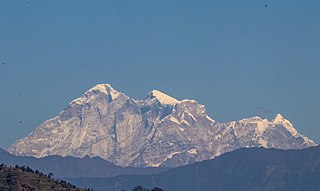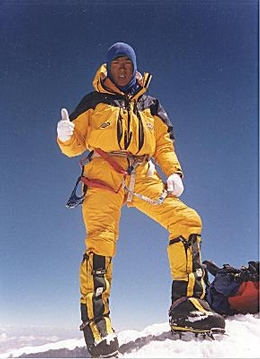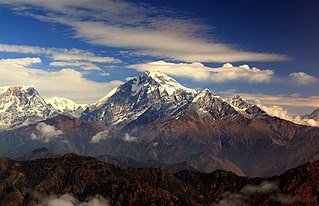Related Research Articles

Lhotse is the fourth-highest mountain on Earth, after Mount Everest, K2, and Kangchenjunga. At an elevation of 8,516 metres (27,940 ft) above sea level, the main summit is on the border between Tibet Autonomous Region of China and the Khumbu region of Nepal.

Cho Oyu is the sixth-highest mountain in the world at 8,188 metres (26,864 ft) above sea level. Cho Oyu means "Turquoise Goddess" in Tibetan. The mountain is the westernmost major peak of the Khumbu sub-section of the Mahalangur Himalaya 20 km west of Mount Everest. The mountain stands on the China–Nepal border, between the Tibet Autonomous Region and Koshi Province.

The eight-thousanders are the 14 mountains recognized by the International Mountaineering and Climbing Federation (UIAA) as being more than 8,000 metres (26,247 ft) in height above sea level, and sufficiently independent of neighbouring peaks. There is no precise definition of the criteria used to assess independence, and at times, the UIAA has considered whether the list should be expanded to 20 mountain peaks by including the major satellite peaks of eight-thousanders. All of the eight-thousanders are located in the Himalayan and Karakoram mountain ranges in Asia, and their summits lie in an altitude known as the death zone.

Dhaulagiri, located in Nepal, is the seventh highest mountain in the world at 8,167 metres (26,795 ft) above sea level, and the highest mountain within the borders of a single country. It was first climbed on 13 May 1960 by a Swiss-Austrian-Nepali expedition. Annapurna I is 34 km (21 mi) east of Dhaulagiri. The Kali Gandaki River flows between the two in the Kaligandaki Gorge, said to be the world's deepest. The town of Pokhara is south of the Annapurnas, an important regional center and the gateway for climbers and trekkers visiting both ranges as well as a tourist destination in its own right. Dhaulagiri is the 55th most topographically prominent peak on Earth.

Shishapangma, or Shishasbangma or Xixiabangma, is the 14th-highest mountain in the world, at 8,027 metres (26,335 ft) above sea level. It is located entirely within Tibet. In 1964, it became the final eight-thousander to be climbed.

Pumori is a mountain on the Nepal-China border in the Mahalangur section of the Himalayas. Pumori lies just eight kilometres west of Mount Everest. Pumori, meaning "the Mountain Daughter" in Sherpa language, was named by George Mallory. "Pumo" means young girl or daughter and "Ri" means mountain in Sherpa language. Climbers sometimes refer to Pumori as "Everest's Daughter". Mallory also called it Clare Peak, after his daughter.

Gaurishankar, a mountain in the Nepal Himalayas, is the second highest peak of the Rolwaling Himal, behind Melungtse (7,181 m). The name comes from the Hindu goddess Gauri, a manifestation of Parvati, and her consort Shankar, denoting the sacred regard it is afforded by the people of Nepal. The Sherpas name the mountain as Jomo Tseringma. The Nepal Standard Time (GMT+05:45) is based on the meridian of this mountain peak.

Alan Hinkes OBE is an English Himalayan high-altitude mountaineer from Northallerton in North Yorkshire. He is the first British mountaineer to claim all 14 Himalayan eight-thousanders, which he did on 30 May 2005.

Elizabeth Hawley was an American journalist, author, and chronicler of Himalayan mountaineering expeditions. Hawley's The Himalayan Database became the unofficial record for climbs in the Nepalese Himalaya. She was also the honorary consul in Nepal for New Zealand.
Benoît Chamoux was a French Alpinist, who claimed to have summited 13 of the Eight-thousanders in the Himalayas.
Carlos Buhler is one of America's leading high altitude mountaineers. Buhler's specialty is high-standard mountaineering characterized by small teams, no oxygen, minimal gear and equipment, and relatively low amounts of funding; yielding first ascents of difficult routes in challenging conditions, such as the Himalayan winter season.
John Roskelley is an American mountain climber and author. He made first ascents and notable ascents of 7,000-meter and 8,000-meter peaks in Nepal, India, and Pakistan. In 2014, he became the 6th winner of the Piolet d'Or Lifetime Achievement Award.

Ang Dorje (Chhuldim) Sherpa is a Nepalese sherpa mountaineering guide, climber, and porter from Pangboche, Nepal, who has reached the summit of Mount Everest 23 times. He was the climbing Sirdar for Rob Hall's Adventure Consultants expedition to Everest in spring 1996, when a freak storm led to the deaths of eight climbers from several expeditions, considered one of the worst disasters in the history of Everest mountaineering.

Samuli Mansikka, was a Finnish Mountaineer and expedition leader. He was president of the Finnish Alpine Club and a member of The Explorers Club. He was best known for climbing the world's 8000m peaks, many of them solo and without supplementary oxygen. He died in a fall while descending from Annapurna, his tenth 8000m summit.
After World War II, with Tibet closing its borders and Nepal becoming considerably more open, Mount Everest reconnaissance from Nepal became possible for the first time culminating in the successful ascent of 1953. In 1950 there was a highly informal trek to what was to become Everest Base Camp and photographs were taken of a possible route ahead. Next year the 1951 British Mount Everest reconnaissance expedition reconnoitred various possible routes to Mount Everest from the south and the only one they considered feasible was the one via the Khumbu Icefall, Western Cwm and South Col. In 1952, while the Swiss were making an attempt on the summit that nearly succeeded; the 1952 British Cho Oyu expedition practised high-altitude Himalayan techniques on Cho Oyu, nearby to the west.
The 1951 British Mount Everest reconnaissance expedition ran between 27 August 1951 and 21 November 1951 with Eric Shipton as leader.

The Dhaulagiri massif in Nepal extends 120 km (70 mi) from the Kaligandaki River west to the Bheri. This massif is bounded on the north and southwest by tributaries of the Bheri River and on the southeast by the Myagdi Khola. The range lies 40 miles northwest of Annapurna and is located in Myagdi District of Nepal.
References
- ↑ Dangar, D.F.O (1984). "A Record of the First Ascents of the Fifty Highest Mountains" (PDF). Alpine Journal. 89. Alpine Club: 184–7. Retrieved April 24, 2011.
- ↑ Hawley, Elizabeth (1995). "Asia, Tibet, Cho Oyu from Tibet in the Post-Monsoon: Climbs And Expeditions". American Alpine Journal. 69 (37).
- ↑ Fox, Charlotte (1997). "A Time to Live, a Time to Die". American Alpine Journal. American Alpine Club Press: 27–36.
- ↑ "Nepal". Everest Summiters Association. Retrieved 4 September 2014.
- ↑ "Everest South Col Route". Αdventurestats.com. Archived from the original on May 28, 2004. Retrieved 4 September 2014.
{{cite web}}: CS1 maint: unfit URL (link) - ↑ Gyalje Sherpa, Mingma. "Himalayan sherpa" . Retrieved 4 September 2014.
- ↑ "Climbing (Expedition) Leaders". Unique Adventure International. Retrieved 4 September 2014.